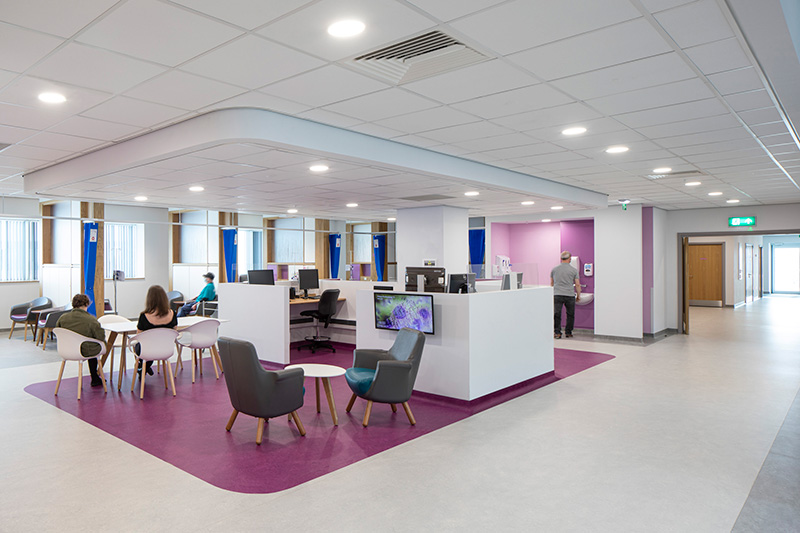- Adapting to change – Healthcare environments should be adaptable and designed to accommodate change – whether changing local demographics or for the introduction of new models of care. The design and layout of furniture should facilitate efficiency and communication to support care co-ordination and information sharing. Efficient space planning should minimise walking distances for both staff and patients.
- Consider the implications of technology – In older furniture layouts, clinicians often had their backs to patients and family members during consultations. With new models of care and the use of tablets, eye contact is maintained, and the consultation process is less intimidating. Clinicians as a result need to be able to move around freely and engage effectively, which further enhances the quality of the patient experience.
- Infection Control – This is central to the processes of any hospital. Fundamental elements of furniture design should underpin the control of contaminant build-up in all patient contact areas. Access for cleaning has to be facilitated by the furniture design and the prevention of dirt traps. Finishes have to be both durable and easily cleaned.
- Creating a positive and healing environment - The appearance of furniture should be attractive and non-institutional. Patient bedrooms are more than a space for a bed and medical equipment but should promote healing and give patients quiet respite that supports recovery. Furniture that is attractive and well maintained creates a positive environment for patients, visitors, and staff. Designers and manufacturers of healthcare facilities are also looking to other sectors such as hospitality to influence the design of spaces and products for patients.
- Privacy considerations - Privacy should also be considered when planning healthcare environments. It is possible to achieve a level of privacy and openness by using architectural wall solutions – such as in chemotherapy units – or mobile furniture to allow hospitals to accommodate each patient's unique needs.
- Meeting the diverse needs of the patient population - Understanding the diverse needs of the patient population can impact on furniture specification to enhance the overall patient experience. Families in children’s hospitals, for example, can spend long periods of time in the wards. Creating attractive, functional furniture with good storage and levels of comfort are key.
- Catering for dementia patients - Patients with dementia may find it difficult to differentiate between items that are the same or a similar colour – for example furniture that is a similar colour to the floor and/or walls may blend in and affect the ability to use it safely. Using bright and contrasting colours for furniture and furnishings, or coloured edging can help these patients to see things more easily.
- Furniture for mental health facilities – This type of furniture will demonstrate how a healthcare provider regards the patient and the expected behaviours. Facilities are often conservative and focus on the anti-ligature specifications in psychiatric care environments. However, there are also models of care which advocate more domestic environments, removing institutional references. Here furniture should be comfortable and high quality; durable, safe, and light. Modern materials can increase durability and lightness, are safer and offer unlimited options to creativity.
- Furniture for waiting areas – This can support a more active and transitional environment – and can be designed to reflect the corporate identity of the healthcare provider in the use of colour and finish selection, as well as determining how comfortable the patients will be.
- Look closely at patient flows – A thorough analysis of each department’s processes and patient flows at the outset is essential. Mock-up rooms can be developed by the manufacturer to help achieve the optimum clinical functionality and aesthetic design.
- Consider life cycle costing – This is important to achieve long-term value but is too frequently overlooked in furniture specification.
- Early engagement with the manufacturer to develop the specification – A good, specialist hospital furniture manufacturer will engage with the design and construction team at an early stage to develop the specification for manufacture and ensure the specific project requirements are met with as few deviations as possible.
- Look at the benefits of pre-assembled furniture - Glue and dowel construction for cabinetry and pre-assembled carcases will radically reduce work and the number of fitters on site and should significantly improve quality. This type of furniture is also more durable to withstand the long-term rigours of a healthcare environment that may be in use 24/7.
- Buy British where possible - A UK-based manufacturer will provide continuity of supply and reduced risk of delays. Lead times should be shorter, particularly in the supply of replacement products – and will support the UK manufacturing economy in these uncertain times.
- Ensure project management capabilities - New build hospital projects typically have many variations in room layouts and more complex specialist items. This requires a high degree of project management to review the programme, manage manufacture and meet the contractor’s stringent delivery schedule. Skilled, trained fitters should be closely supervised by the furniture supplier’s directly employed project manager to maintain the quality of fitting out.
- The importance of specialist expertise - A track record in healthcare is strongly recommended so the manufacturer can demonstrate a clear understanding of project requirements and detailed specifications – from producing compliant and accurate tenders, to developing designs that reflect best practice in infection control.

